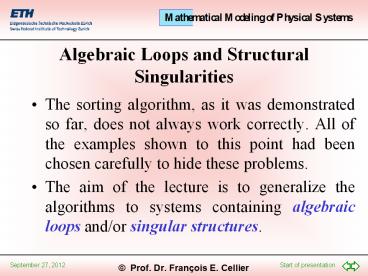Algebraic Loops and Structural Singularities - PowerPoint PPT Presentation
Title:
Algebraic Loops and Structural Singularities
Description:
Table of Contents. Algebraic loops. Structure diagram ... FG = FI Fk2 FB2 m g. tT1 = J1 d. 1 dt. d. 1 dt. tT2 = J2 d. 2 dt. d. 2 dt. FI = m ... – PowerPoint PPT presentation
Number of Views:41
Avg rating:3.0/5.0
Title: Algebraic Loops and Structural Singularities
1
Algebraic Loops and Structural Singularities
- The sorting algorithm, as it was demonstrated so
far, does not always work correctly. All of the
examples shown to this point had been chosen
carefully to hide these problems. - The aim of the lecture is to generalize the
algorithms to systems containing algebraic loops
and/or singular structures.
2
Table of Contents
- Algebraic loops
- Structure diagram
- Structural singularities
- Differentiation
3
Algebraic Loops An Example
Component equations U0 f(t) u3 R3 i3 u1
R1 i1 uL L diL/dt u2 R2 i2 Node
equations i0 i1 iL i1 i2 i3 Mesh
equations U0 u1 u3 uL u1 u2 u3 u2
The circuit contains 5 components ?
We require 10 equations in 10 unknowns
4
Horizontal Sorting I
1.
2.
4.
3.
5
Horizontal Sorting II
Of the six equations that are still a-causal
(i.e., the equations not containing a red
variable), every one contains at least two
unknowns. Furthermore, every one of the unknowns
shows up in at least two of the a-causal
equations.
?
Such a situation indicates the existence of
algebraic loops.
6
Algebraic Loops I
We choose one unknown from one equation, e.g.
variable i1 from equation 4. We assume this
variable to be known and continue as before.
2.
1.
3.
4.
7
Algebraic Loops II
Structure diagram
8
Solution of Algebraic Loops I
?
i1 i2 i3 u2 / R2 u3 / R3 u3 /
R2 u3 / R3 ((R2 R3 ) / (R2 R3 ))
u3 ((R2 R3 ) / (R2 R3 )) (U0 - u1 )
((R2 R3 ) / (R2 R3 )) (U0 - R1 i1 )
?
9
Solution of Algebraic Loops II
?
The algebraic loop has now been solved, and we
can continue with the sorting algorithm as before.
10
Horizontal Sorting III
11
Multiple Coupled Algebraic Loops
12
Structural Singularities An Example
The mixed rotational and translational system
exhibits three bodies the inertiae J1 and J2 as
well as the mass m. Therefore, we would expect
the system to be of 6th order.
3 bodies ? 6 differential equations 3 algebraic
equations (DAlembert) 3 frictions ? 3 algebraic
equations (friction forces) 2 springs ? 2
algebraic equations (spring forces) 1 gear ? 2
algebraic equations (transmission)
13
Modeling of the Gear
We cut through the gear. The effect of the other
body is replaced by a cutting force.
?
The torque t is proportional to the cutting
force F, and the displacement x is proportional
to the angle ?.
14
Cutting the System
15
Horizontal Sorting I
Idea If an equation holds true for all times,
then every derivative of that equation holds
true as well.
16
Differentiation I
17
Differentiation II
18
Horizontal Sorting II
?
19
Horizontal Sorting III
There still remain 6 equations in 6 unknowns.
20
Algebraic Loop
?
21
Horizontal Sorting IV
?
22
Solution of the Algebraic Loop I
tT2 / J2
(tB1 - tk1 - tG ) / J2
(tB1 - tk1 ) / J2 - tG /J2
(tB1 - tk1 ) / J2 - (r /J2 ) FG
(tB1 - tk1 ) / J2 - (r /J2 ) (FI Fk2 FB2
mg)
(tB1 - tk1 ) / J2 - (r /J2 ) (Fk2 FB2
mg) - (r /J2 ) FI
(tB1 - tk1 ) / J2 - (r /J2 ) (Fk2 FB2
mg) - (mr /J2 ) dv/dt
(tB1 - tk1 ) / J2 - (r /J2 ) (Fk2 FB2
mg) - (mr2 /J2 ) d?2 /dt
23
Solution of the Algebraic Loop II
tT1 t (t) - tB1 - tB3 tT2 tB1 - tk1 - tG FG
FI Fk2 FB2 m g
tG r FG
dv
d?2
r
dt
dt
tB1 B1 (?1 ?2 ) tB3 B3 ?1 FB2 B2
v tk1 k1 ?2 Fk2 k2 x
24
Comments
- The problem of the structural singularity
occurred, because the mass m and the inertia J2
cannot be moved independently of each other. - For this reason, it had to be possible to
describe the system by only 4 differential
equations. - The solution approach presented here does not
exploit that simplification directly. - A better approach shall be explained in due
course.
25
References
- Cellier, F.E. and H. Elmqvist (1993), Automated
formula manipulation supports object-oriented
continuous-system modeling, IEEE Control
Systems, 13(2), pp. 28-38.































